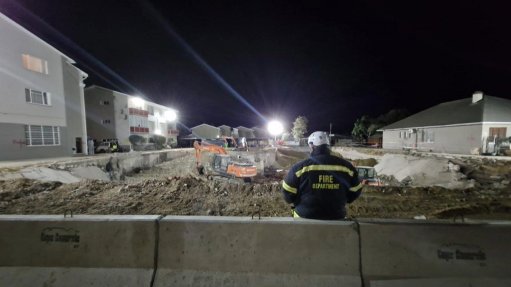Climate commission model points to the growth potential of green industrialisation
The initial direct cost of placing South Africa on an energy transition pathway over the coming five years in line with its decarbonisation targets is calculated at a hefty R1.5-trillion in the Just Energy Transition Investment Plan (JET-IP).
Less visible, however, are the socioeconomic costs associated with failing to pursue the Nationally Determined Contribution (NDC) goal of reducing carbon dioxide-equivalent (CO2-eq) emissions to the lower end of the NDC range of between 420-million and 350-million CO2-eq tons in 2030.
The lower target is said to be compatible with South Africa’s fair contribution to helping to cap the global rise in temperatures to 1.5°C above pre-industrial levels.
To assess these direct and indirect costs, the Presidential Climate Commission (PCC) and Cambridge Econometrics have applied Cambridge Econometrics’ E3ME model in a bid to understand the trade impacts of future policy choices and the economic impacts associated with the environmental damage caused by higher temperatures.
The macroeconomic simulation model has been used in this instance to capture the socioeconomic and energy implications for South Africa under conditions where the country and the world adopt decarbonisation paths, premised on:
- a business-as-usual outcome calibrated to the stated energy policies of governments, as articulated by the International Energy Agency and where no carbon border adjustment measures are implemented and no just transition funding is available for South Africa; and
- a 1.5°C compatible pathway for South Africa and the rest of the world, that assumes energy system decarbonisation plans for South Africa somewhat more ambitious than the prevailing Integrated Resource Plan, as well as carbon taxation, recycling of carbon tax revenues, just transition funding and global carbon border adjustment measures.
These outcomes have been tested against four scenarios, including one where both South Africa and the rest of the world pursue business-as-usual pathways. A second scenario where South Africa pursues a 1.5°C-compatible pathway and the rest of the world remains on a business-as-usual trajectory. Thirdly, where South Africa implements a business-as-usual policy and the rest of the world a 1.5°C-compatible pathway. And fourth, where both South Africa and the rest of the world aim for the 1.5°C-compatible, or net-zero, pathway.
PCC head of climate mitigation Steve Nicholls tells Engineering News that, when climate-related loss and damage is excluded, the model shows South Africa fairing best from a growth and employment perspective under a scenario where it implements net-zero policies and the rest of the world remains on a business-as-usual pathway.
Growth would be 7.5% better by 2030 and 5.2% higher by 2040, while employment would be 0.8% and 1.5% higher for the same periods respectively. However, the associated 3°C global temperature pathway could offset those gains as the country faced more and increasingly costly extreme weather events, for example from floods and droughts.
The most economically and employment damaging scenario for South Africa, however, would be one where it adopted a business-as-usual stance, while the rest of the world implemented 1.5°C-compatible policies.
Under such a scenario, the model shows that South Africa’s gross domestic product (GDP) would be 4.2% lower in 2030 and 3.9% lower by 2040 than under a scenario where the rest of the world also remained on a business-as-usual pathway. Likewise employment creation would be far weaker.
The key reason for the decline, Nicholls explains, would be the loss of exports as the rest of the world imposes carbon border adjustment measures on South Africa’s higher-carbon products.
The model shows that several domestic sectors, including agriculture, construction, industry, energy, services and transport would benefit from a net-zero transition, but that the scale and distribution would depend on developments elsewhere.
Overall, the results show that investments related to the transition can create new jobs and add to economic activity, while just transition investments and financial support are likely to be necessary to mitigate losses in certain areas.
It also indicates that South Africa has a direct interest in limiting climate damage, which could undermine productivity and infrastructure and adversely impact vulnerable groups with limited means for adaptation.
“A global 1.5°C pathway can mean over 5% of GDP avoided losses,” the model shows.
Nicholls stresses, however, that such modelling results are never perfect. Instead, the exercise gives a good indication of how South Africa should think about dealing with risk and uncertainty. It also adds to a growing body of evidence that suggests that a green industrial growth path is a lower risk and higher reward strategy for South Africa, when compared to fossil fuel-intense options.
It also points to the potential benefits of investing in net-zero projects that have already been identified in the JET-IP.
The PCC quotes various studies that in aggregate suggest that these and other investments in green industrialisation could result in five-million new jobs, protect 1.2-million vulnerable jobs, reduce the number of people living in poverty by 30% and lower yearly deaths linked to air pollution by 2 300.
It is obvious, Nicholls says, that South Africa must invest in growing the economy, “the question we need to resolve is which pathway could generate the most return for the most people at the least risk”.
“Through these investment we could double GDP and create an opportunity to significantly reduce inequality through enterprise creation and social ownership schemes”.
“Therefore, I would argue that systemically pursuing change, with our eyes wide open to the challenges, is the best way forward,” Nicholls concludes.
Comments
Announcements
What's On
Subscribe to improve your user experience...
Option 1 (equivalent of R125 a month):
Receive a weekly copy of Creamer Media's Engineering News & Mining Weekly magazine
(print copy for those in South Africa and e-magazine for those outside of South Africa)
Receive daily email newsletters
Access to full search results
Access archive of magazine back copies
Access to Projects in Progress
Access to ONE Research Report of your choice in PDF format
Option 2 (equivalent of R375 a month):
All benefits from Option 1
PLUS
Access to Creamer Media's Research Channel Africa for ALL Research Reports, in PDF format, on various industrial and mining sectors
including Electricity; Water; Energy Transition; Hydrogen; Roads, Rail and Ports; Coal; Gold; Platinum; Battery Metals; etc.
Already a subscriber?
Forgotten your password?
Receive weekly copy of Creamer Media's Engineering News & Mining Weekly magazine (print copy for those in South Africa and e-magazine for those outside of South Africa)
➕
Recieve daily email newsletters
➕
Access to full search results
➕
Access archive of magazine back copies
➕
Access to Projects in Progress
➕
Access to ONE Research Report of your choice in PDF format
RESEARCH CHANNEL AFRICA
R4500 (equivalent of R375 a month)
SUBSCRIBEAll benefits from Option 1
➕
Access to Creamer Media's Research Channel Africa for ALL Research Reports on various industrial and mining sectors, in PDF format, including on:
Electricity
➕
Water
➕
Energy Transition
➕
Hydrogen
➕
Roads, Rail and Ports
➕
Coal
➕
Gold
➕
Platinum
➕
Battery Metals
➕
etc.
Receive all benefits from Option 1 or Option 2 delivered to numerous people at your company
➕
Multiple User names and Passwords for simultaneous log-ins
➕
Intranet integration access to all in your organisation





















